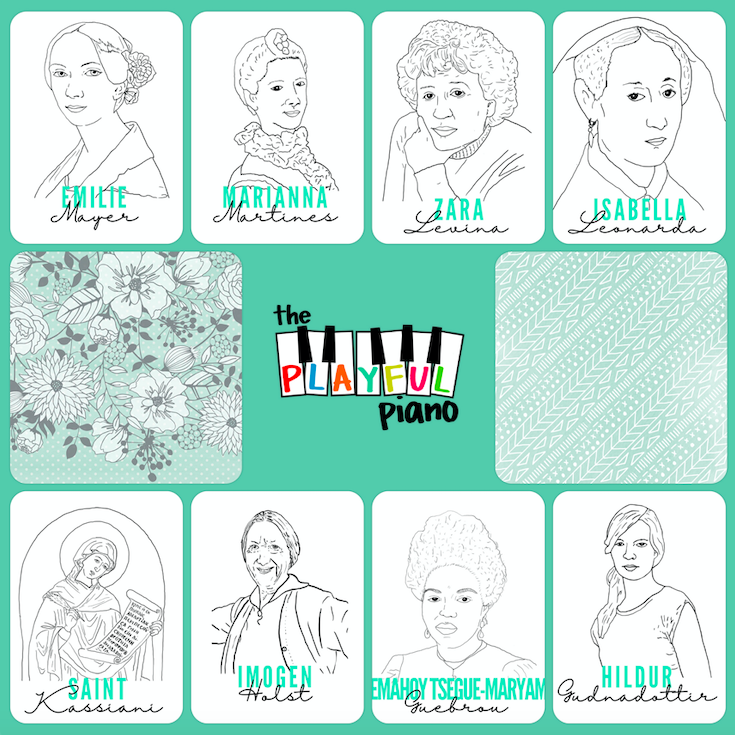As piano teachers we have so many things we need to teach our students! Not only are we teaching them an entirely new language – how to understand it, how to read it, how to write it – but we are also teaching them how to play correctly, how to listen and create beautiful sounds, how to practice, how to memorize, how to perform, and much more! On top of all that, I believe we should be teaching music history to our piano students. I know, I know…there are only so many minutes in a lesson! It may be a challenge to fit it in, but I believe that it is worth it and it is important, for these 9 reasons:
1 – Music History Inspires Practice
As students get to know new-to-them composers and pieces, they will find music that they absolutely love and want to learn! Teaching music history and listening/appreciation opens up new worlds of music to our students. As they discover pieces that they love, they will start to practice more because they are loving the music they are playing.
2 – Gives Musical Role Models
Learning about the lives of the composers can be super inspiring to young musicians. When students learn about a composer they can relate to on some level, they can see a little of themself in that composer and it can help them to feel that they can accomplish great things in music as well. For example, when I learned about the life of modernist composer Ruth Crawford Seeger I was so inspired by her life as a devoted mother, an inspiring piano teacher and as a person who was creative in so many aspects of her life. It made me want to be more like her!
3 – Gives Context to Pieces
Learning the back story of a piano piece you are learning makes that piece come alive in new ways. A great way to fit music history education into a piano lesson is to have students research the pieces they are playing and find out what was happening in the composer’s life when they wrote it. For example, in researching Florence Price’s beautiful piano piece “Clouds,” I learned that clouds are a symbol of freedom often used in African American art, literature and poetry. Price uses this symbol as the subject of her piece; she combines that with the element of traditional white classical music. This could be a reflection of her own life experiences, in which she experienced discrimination based on her race and sex.
4 – Reveals Musical Preferences
A student is not going to have a favorite composer until they have listened and performed music by several different composers in different styles, genres and musical eras. It’s so important to listen!
5 – Understand and Appreciate Classical Music
It’s important for an aspiring pianists to be familiar with Bach preludes and fugues, Chopin preludes and mazurkas, and Beethoven sonatas. These works are an important legacy and part of being a pianist. Even if our students are not aspiring to be great classical pianists, these works are important in understanding the history and the possibilities of our wonderful instrument.
6 – Helps Fulfill Need for Relatedness
Scientists have found that in order to be self-motivated, a person needs three things: competence, autonomy and relatedness. As a piano student, relatedness has to do with how the things they are learning in lessons relate to other parts of their life. Not all students will come from homes where they hear classical music on a regular basis. As a student starts piano lessons, classical music may be a foreign thing to them. Finding ways to help students and parents be exposed to classical music can really help their success and motivation in the long-run as they get used to what classical piano music sounds like.
7 – Develops Ear and Listening Skills
Musicians create music, which is all about sound. In order to help our students create beautiful sounds at the piano, we need to help them develop and fine-tune their listening skills. What better way than to have them listen to music of different styles, moods, eras, and composers? Better yet, have them listen to several recordings of the same piece to hear different articulations and interpretations.
8 – Music Moves, Edifies, Enlightens
Why does anyone become a musician in the first place? Could it be because music has an inherent ability to inspire, to move you to feel emotions, to transport you and your thoughts and feelings to a different realm, to enlighten and edify? Think of a time when you heard a beautiful piece of music that was so gorgeous or surprising or amazing that you had to stop what you were doing to just listen. Or a time when you heard an amazing piece for the first time and had to put it on repeat and listen over and over again. We want these experiences for our students! We want them to discover beautiful music that their lives are incomplete without knowing. As they have wonderful experiences with music, they will be more likely to create beautiful experiences by sharing their music with others.
9 – Well-Rounded Musicians
A student who is well-versed in the important composers for our instrument, understanding what different eras and genres of piano music sound like and appreciating the beauty in each one, will be a more mature and well-rounded musician. Even if they don’t love every composer and every type of music, they will start to have an appreciation for them that will help them become more well-rounded in their musical abilities.
Looking for easy-to-implement music history resources? I’ve got you covered! Visit the Music History category in my shop for so many ideas and activities!




























































